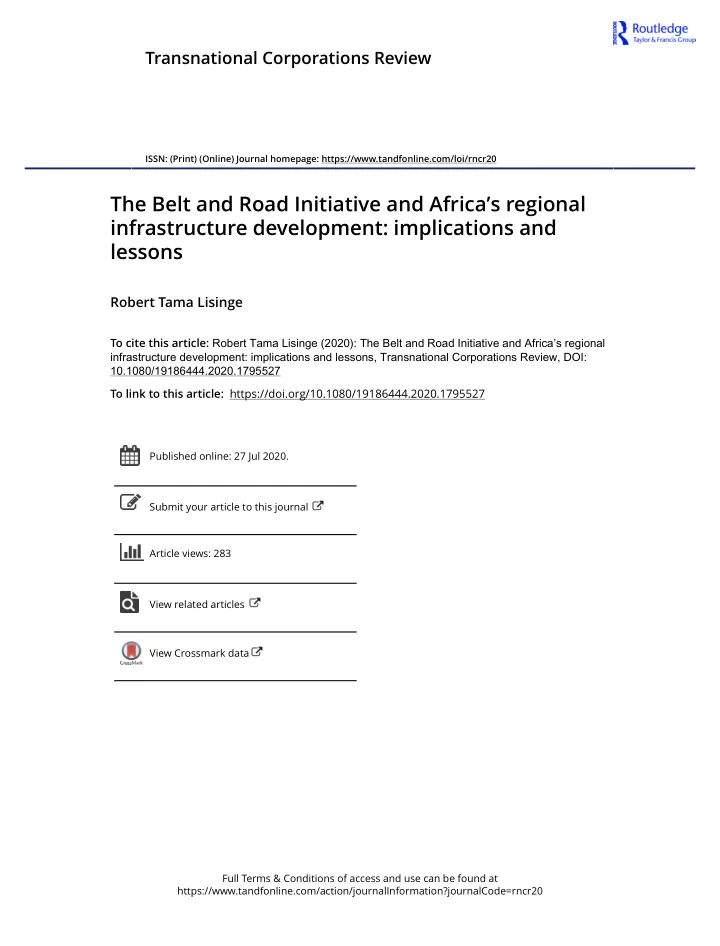

Transnational Corporations Review ISSN: (Print) (Online) Journal homepage: https://www.tandfonline.com/loi/rncr20 The Belt and Road Initiative and Africa’s regional infrastructure development: implications and lessons Robert Tama Lisinge To cite this article: Robert Tama Lisinge (2020): The Belt and Road Initiative and Africa’s regional infrastructure development: implications and lessons, Transnational Corporations Review, DOI: 10.1080/19186444.2020.1795527 To link to this article: https://doi.org/10.1080/19186444.2020.1795527 Published online: 27 Jul 2020. Submit your article to this journal Article views: 283 View related articles View Crossmark data Full Terms & Conditions of access and use can be found at https://www.tandfonline.com/action/journalInformation?journalCode=rncr20
TRANSNATIONAL CORPORATIONS REVIEW https://doi.org/10.1080/19186444.2020.1795527 ARTICLE The Belt and Road Initiative and Africa ’ s regional infrastructure development: implications and lessons Robert Tama Lisinge Energy, Infrastructure and Services Section, Private Sector Development and Finance Division, United Nations Economic Commission for Africa, Addis Ababa, Ethiopia ABSTRACT ARTICLE HISTORY The Belt and Road Initiative (BRI) is outward-looking, being part of China ’ s ‘ Going Out Strategy ’ Received 22 October 2019 Revised 29 April 2020 while Africa ’ s current regional infrastructure programmes are primarily inward-looking as they Accepted 9 July 2020 seek to deepen the continent ’ s regional integration. This paper argues, drawing from inter- national cooperation theory, that China and Africa can cooperate in implementing BRI despite KEYWORDS the apparent conflict in their infrastructure connectivity aspirations. They can coordinate their Belt and Road Initiative; policies for the purpose of mutual benefit through enhanced connectivity and trade between Africa; regional Africa and China on the one hand and deepened African regional integration and intra-African infrastructure; transport; trade on the other. This could be achieved by using Africa ’ s regional programmes as building programmes; China; blocks for cooperation in BRI. This paper also highlights lessons from BRI that Africa could use cooperation to fast-track implementation of its own initiatives including the mobilisation of stakeholders by political leaders, creation of dedicated institutions and funds, and building of local capacity in the infrastructure sector. 1. Introduction The Belt and Road Initiative (BRI), launched in 2013 by President Xi Jinping, is widely considered to be the centre- piece of China ’ s new foreign policy and a reflection of its ascendancy in the global arena, economically, politic- ally, and strategically. Many researchers view BRI as a multifaceted and connectivity-oriented grand strategy designed to serve China ’ s ambitious geostrategic and geo-economic interest. Its importance to China is under- scored by the substantial financial, diplomatic, and intellectual resources that the country has already committed to the initiative (Casarini, 2016; Minghao, 2016; Rolland, 2017; Yu, 2017; Zhao, 2020; Zhou & Esteban, 2018). A broad range of factors have been identified as the motivators of BRI. Wang (2016) suggests that the initiative emerged from the combined pressure of slowing down of Chinese economy, US pivot to Asia and deterioration of the relationship with neighbouring countries after weathering the storm of the global financial crisis in 2008. For Liu and Dunford (2016), BRI reflects China ’ s rise as a global power, industrial redeployment, increased out- ward investment and need to diversify its energy sources and routes. Zhou and Esteban (2018) consider it as an initiative that serves as a decisive strategic manoeuvre for China to ensure security and promote power status in the international order, moving from rule-taker to rule-maker. According to Ye (2019), BRI is a mobilisation cam- paign of the Chinese political leaders in order to deal with domestic and diplomatic challenges. For Africa, cooperation with China on infrastructure development started much earlier than the launch of BRI. For instance, China was involved in the construction of the TAZARA railway linking Tanzania and Zambia in the 1970s. Being an inter-continental connectivity initiative, many expect BRI ’ s benefits in Africa to be regional in nature. However, China ’ s past approach to partnership on infrastructure development in Africa may shape the tra- jectory of BRI on the continent. This concern has rekindled the debate on whether China ’ s partnership with Africa focusses more on bilateral than multilateral cooperation. This debate raises pertinent questions. For instance, what are the incentives for China to invest in Africa ’ s regional infrastructure projects? What strategies could Africa pursue to optimise its benefits from BRI from a regional perspective? The objective of this paper is to answer these questions. The paper uses international CONTACT Robert Tama Lisinge lisinge@un.org Energy, Infrastructure and Services Section, Private Sector Development and Finance Division, United Nations Economic Commission for Africa, Menelik II Ave, Addis Ababa, Ethiopia � 2020 Denfar Transnational Development INC.
Recommend
More recommend